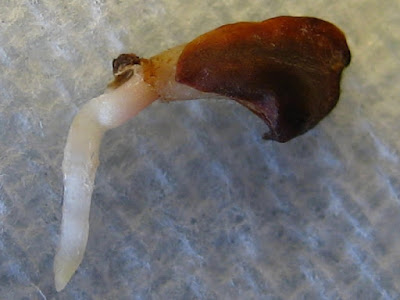 As these trees get older, the leaves at the top of the trees become needles, which helps conserve moisture in the dry heat of the canopy. The lower branches will keep flat leaves such as these.
As these trees get older, the leaves at the top of the trees become needles, which helps conserve moisture in the dry heat of the canopy. The lower branches will keep flat leaves such as these.
Monday, October 22, 2007
Coast Redwood Leaves Close-up
 As these trees get older, the leaves at the top of the trees become needles, which helps conserve moisture in the dry heat of the canopy. The lower branches will keep flat leaves such as these.
As these trees get older, the leaves at the top of the trees become needles, which helps conserve moisture in the dry heat of the canopy. The lower branches will keep flat leaves such as these.
Seed #7 - Growing Like Crazy
Sunday, July 29, 2007
Seed #8 - Branches
Thursday, July 26, 2007
Coast Redwoods at Kew Gardens
Sunday, July 22, 2007
Seed #19 - Spiral Leaf Pattern
Saturday, June 16, 2007
Cold Stratification
There's been little activity with my coffee filter baggie seeds in the past couple of weeks, so I'm trying cold stratification. Germination rate in coast redwoods will increase when their dormancy period is overcome by extended periods of near-freezing temperatures. I've moved the seeds into baggies of moist seed-starting soil (mostly peat moss) in my refrigerator. In two months, I'll remove them from the cold, and keep the baggies out in the open where they may receive indirect sunlight. When the seedlings start germinating, I'll move them into their own cel-packs.
I wrote a more detailed post on cold stratification and the soil baggie method in my giant sequoias blog, if you're interested.
I wrote a more detailed post on cold stratification and the soil baggie method in my giant sequoias blog, if you're interested.
Thursday, June 14, 2007
Thursday, June 7, 2007
Seed #3 - Sprout
Wednesday, June 6, 2007
Tuesday, June 5, 2007
Saturday, June 2, 2007
Seed #7 - Radicle
This is not a Coast Redwood Sprout
Wednesday, May 30, 2007
Seed #2 - Radicle
 My one mistake today was in leaving these newly-germinated seeds out of water for thirty minutes before planting them in their cel-packs. I think they'll be okay, but when I did get around to planting them, even though I had sprayed them with spring water, the radicles had shriveled up a little bit. I'm going to have to be careful in the future.
My one mistake today was in leaving these newly-germinated seeds out of water for thirty minutes before planting them in their cel-packs. I think they'll be okay, but when I did get around to planting them, even though I had sprayed them with spring water, the radicles had shriveled up a little bit. I'm going to have to be careful in the future.
Seed #1 - Radicle
Friday, May 25, 2007
Getting Started...
 This is my first attempt at growing coast redwood (Sequoia sempervirens) from seeds. The seeds are harder and darker in color than those of giant sequoias. The deep color is most likely due to a high concentration of tannin.
This is my first attempt at growing coast redwood (Sequoia sempervirens) from seeds. The seeds are harder and darker in color than those of giant sequoias. The deep color is most likely due to a high concentration of tannin.To begin, I'm soaking one-hundred seeds in aerated spring water overnight. In the morning, I will set the seeds up with the baggie method to pre-germinate them before putting them in the cel-pack greenhouse. For the baggie method, I fold the seeds into wet, unbleached coffee filters, and keep them in the dark in ziplock bags until the seeds' radicles (embryonic roots) start emerging. At that point, the seeds can be transplanted into seed-starting soil in my cel-pack mini-greenhouse.
I'm not expecting a high germination rate from these seeds. In fact, I'll be thrilled if I can get ten good seedlings from this batch. Seeing that it may take up to ninety days for some of these to germinate, it's important not to keep them in the greenhouse long enough that they develop mold. This is why the baggie method is so helpful. If I can protect the seeds until they germinate, and only keep them in the greenhouse until they sprout, then my chances of mold are much lower.
Coast redwood seedlings develop quickly - it's possible that they may reach eighteen inches tall in their first year. These are the tallest trees in the world, reaching over 350 feet tall! As long as they're watered often, and given enough time, there's no reason these trees couldn't reach that height in my back yard... aside from my neighbors...
Subscribe to:
Comments (Atom)


































